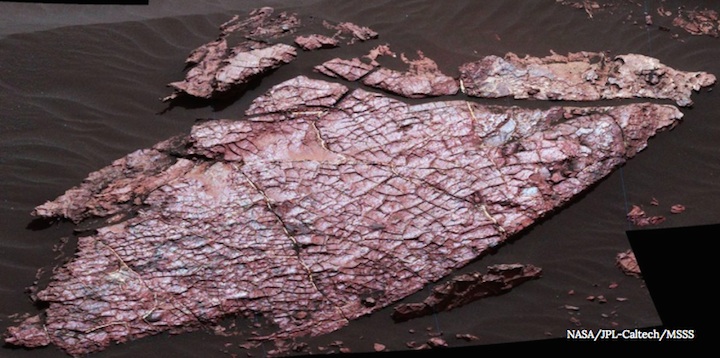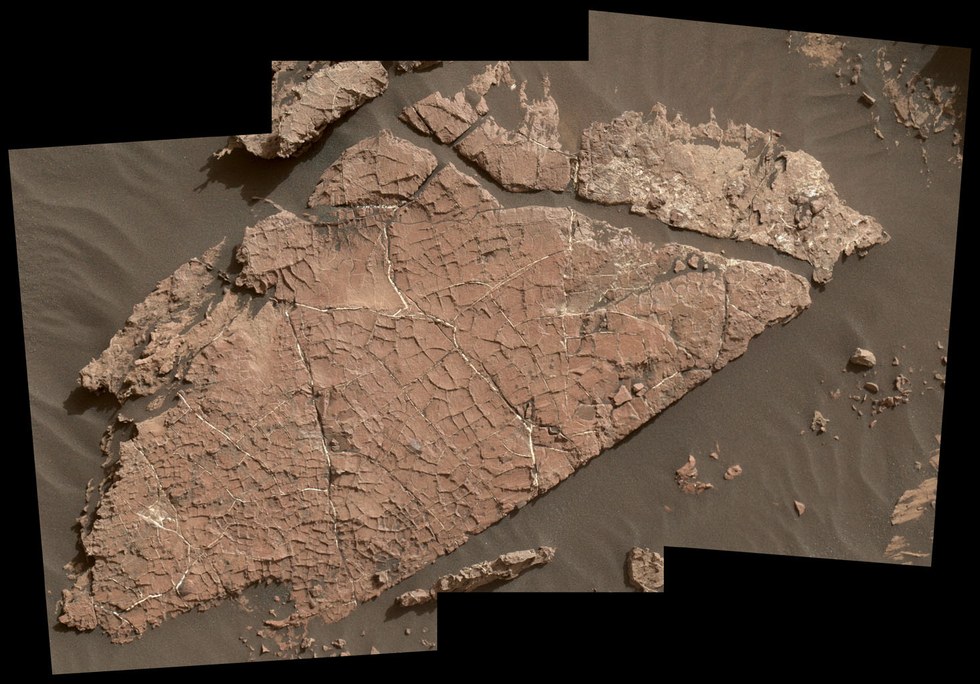NASA/JPL-Caltech/MSSS
.
Curiosity Finds Fossilized Slab of Cracked Mud on Mars
The sedimentary rock, called "Old Soaker" by the Mars rover team, was likely once part of a lake bed three billion years ago.

NASA's Mars rover Curiosity has found yet another peculiar rock on the Red Planet's surface — and this one has a distinct Earth-like flavor.
Lying out in the open, the slab looks like a patch of dried-out mud you might find in the basin of a parched river or lake bed. And, as it turns out, that's exactly what this might be.
Nicknamed "Old Soaker" by the rover team, and photographed by Curiosity on Dec. 31, this fascinating-looking rock is yet another piece of stunning evidence that the rover is exploring materials that were formed out of the sediment at the bottom of a lake.
"Mud cracks are the most likely scenario here," said Nathan Stein, of the Curiosity science team and a graduate student at Caltech in Pasadena, Calif. "Even from a distance, we could see a pattern of four- and five-sided polygons that don't look like fractures we've seen previously with Curiosity."
"It looks like what you'd see beside the road where muddy ground has dried and cracked."
If confirmed, these polygonal shapes will be the first fossilized mud cracks (formally known as desiccation cracks) found by the mission. Discovered on the lower slopes of Mount Sharp, Old Soaker lies above minerals that are known to form in wet conditions and, according to satellite observations, there's more mudstone further up the mountain.
A top-down view of Old Soaker, as imaged by Curiosity's Mars Hand Lens Imager (MAHLI) camera (NASA/JPL-Caltech)
To form the rock Curiosity sees today, several processes have taken place. Three billion years ago, mud from a lake bed was exposed and dried; it then cracked and was covered with more layers of sediment, filling the cracks. This layering formed stratified rock. Over time, the upper layers of rock became eroded away by Martian winds, revealing the ancient cracked mud layer as a system of raised ridges.
Raised ridges in rock have been found in numerous occasions by the rover. Usually these ridges are formed by the accumulation of minerals that solidify inside cracks. As these minerals form, they become more resistant to erosion than the rock they form in. Over time, the softer rock erodes away, producing interwoven veins of bright minerals that can be used by geologists to understand when and how the rock formed.
In addition to desecration cracks, Old Soaker appears to also have fractures that were infilled with veins of other minerals through processes involving a plentiful supply of liquid water, creating an open geological book for eons of formation process.
"If these are indeed mud cracks, they fit well with the context of what we're seeing in the section of Mount Sharp Curiosity has been climbing for many months," said Ashwin Vasavada, Curiosity Project Scientist of NASA's Jet Propulsion Laboratory in Pasadena. "The ancient lakes varied in depth and extent over time, and sometimes disappeared. We're seeing more evidence of dry intervals between what had been mostly a record of long-lived lakes."
Since landing in 2012, Curiosity has added an incredible amount of information to our knowledge of the Red Planet's once wet and potentially habitable past — this very Earth-like discovery of cracked mud is yet another strangely familiar geological find that proves liquid water persisted for long periods on ancient Mars. But did water and the chemicals necessary for life persist long enough for a basic Martian biology to evolve? That tantalizing question remains unanswered, for now.
Quelle: Seeker

